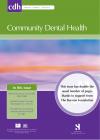Community Dental Health

- Cover Date:
- March 2011
- Print ISSN:
- 0265 539X
- Vol:
- 28
- Issue:
- 1
Short Communication - Actinic Cheilitis among agricultural workers in Campinas, Brazi
Objective To assess the prevalence of Actinic Cheilitis (AC) among agricultural workers and analyze its risk factors. Design A cross sectional epidemiological study. A lip lesion was defined as an abnormal change on the lip mucosa surface, such as erythematous pigmented, ulcerative or swelling (Cataldo and Doku, 1981). Data were gathered according to age group, gender, ethnicity, time and frequency of occupational sunlight exposure, smoking habits, drinking habits and socio-economic status. Setting Sugar-cane plantation farms in Brazil. Participants Full-time workers of both genders employed at sugar-cane plantation farms for at least six months. Outcome measures Correlations between AC prevalence, demographic and socioeconomic risk factors. Results 202 people were examined and the prevalence of AC was 39.6%. Results revealed that being black (0.15-0.88- 95%CI; OR=0.36; p=0.025) or mulatto (0.21-0.82- 95%CI; OR=0.42; p=0.011) decreased the risk for AC, while age and gender sex had no effect. In relation to socioeconomic variables, formal education and more than four years of education (0.07-0.68- 95%CI; OR=0.22; p=0.009) decreased the risk for AC. Moreover, drinking alcohol was a risk for AC (1.05-3.37- 95%CI; OR=1.88; p=0.034), while tobacco smoking was not (0.60-2.02- 95%CI; OR=1.10; p= 0.763). Conclusions The prevalence of AC is high in agricultural workers who were fairskinned, had low education and high alcohol intake. Prevention and early diagnosis are required for workers exposed to sunlight.
Key words: Actinic Cheilitis, epidemiology, lip, prevalence, risk factors.
- Article Price
- £15.00
- Institution Article Price
- £
- Page Start
- 60
- Page End
- 63
- Authors
- J.L.R. Junqueira, M. Bönecker, C. Furuse, P. de Camargo Morais, F.M. Flório, P.R. Cury, V.C. Araújo
Articles from this issue
- Title
- Pg. Start
- Pg. End
- The caries experience of 5 year-old children in Scotland, Wales and England in 2007-2008 and the impact of consent arrangements. Reports of co-ordinated surveys using BASCD criteria
- 5
- 11
- The dilemma of selecting suitable proximal carious lesions in primary molars for restoration using ART technique.
- 12
- 16
- Using laser fluorescence (DIAGNOdent) in surveys for the detection of noncavitated occlusal dentine caries
- 17
- 21
- The prevalence of and risk factors for non-carious cervical lesions in adults in Hubei Province, China
- 22
- 28
- Health-related lifestyle behaviours, socio-demographic characteristics and use of dental health services in Greek adults.
- 47
- 52
- Periodontal health and treatment needs among hospitalized chronic psychiatric patients in Istanbul, Turkey
- 69
- 74
- Comparison of the COHIP and OHIP- 14 as measures of the oral health-related quality of life of adolescents
- 82
- 88
- Assessment and comparison of periodontal status among young smokers and nonsmokers of Bangalore, India - a cross sectional study.
- 89
- 94
- Smoking and drinking habits and attitudes to smoking cessation counselling among Tanzanian dental students
- 95
- 98
- Traumatic dental injuries to primary incisors and the terminal or occlusal plane relationship in Indian preschool children
- 104
- 106
- Teaching dental public health to undergraduates using community profiles and patient case studies
- 116
- 120
